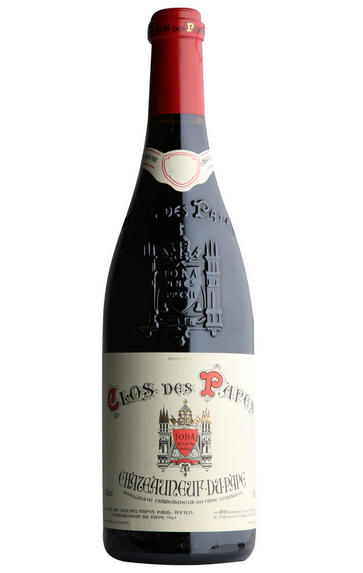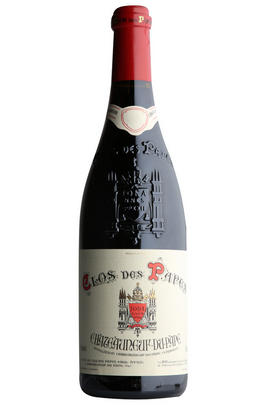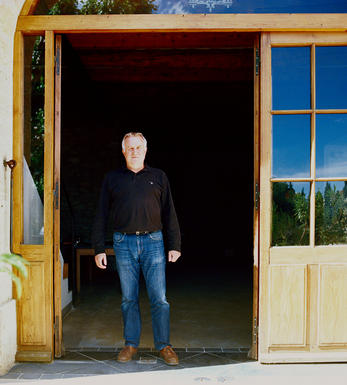
2013 Châteauneuf-du-Pape Rouge, Clos des Papes, Paul Avril & Fils, Rhône

Critics reviews
Jeb Dunnuck - 30/10/2015
Jancis Robinbson - jancisrobinson.com - 30-Oct-2014
About this WINE

Paul Avril et Fils
With Vincent Avril at the helm, Clos des Papes is one of the most highly regarded properties; not only in Châteauneuf-du-Pape, but in the world of wine. This family estate has been certified organic for 15 years, with high attention to detail translating into impressively low production levels. Given that the vines here average over 50 years of age, they are firmly prepared and able to withstand many ordeals, including Mistral winds at 140 kilometres an hour, severe heatwaves and drought conditions. Thankfully, they were spared from the latter two in 2020.
When you visit this iconic estate, what stands out most is the complete focus on the vineyard and the absolutely hands-off approach in the cellar. The wines are amongst the purest expression of terroir you could ever wish to taste. There is a magic here that transcends the liquid in the bottle – Clos des Papes is a nonpareil of sheer brilliance.
Vincent is exceptionally happy with his ’20 wines, saying, “I can tell you ’20 is, I think, a great year that will stand the test of time. A very balanced, fine vintage with great freshness, silky tannins and good length in the mouth. Everything was climatically united, both for the red and the white. Currently, ’20 reminds me of ’05 and ’07.”

Châteauneuf-du-Pape
The most celebrated village of the Southern Rhône, Châteauneuf-du-Pape is the birthplace of the now indispensable French Appellation d’Origine Contrôlée system – imperfect though it may be. Compared to the Northern Rhône, the vineyards here are relatively flat and often feature the iconic galet pebbles – the precise benefits of which are a source of much debate. Minimum alcohol levels required by the AOC are the highest in France, but at 12.5% it is well below the natural generosity of Grenache, which only achieves its full aromatic potential when it is fully ripe and laden with the resultant high sugars. Syrah and Mourvèdre contribute the other defining elements in the blend, adding pepper, savoury spice and structure to the decadent Grenache. There are a further 10 permitted red grape varieties which can be used to adjust the “seasoning”. Of the five white varieties permitted, it is Grenache Noir’s sibling – predictably perhaps – Grenache Blanc, which dominates, though Roussanne shows a great deal of promise when handled well, notably at Château de Beaucastel.

Southern Rhône Blend
The vast majority of wines from the Southern Rhône are blends. There are 5 main black varieties, although others are used and the most famous wine of the region, Châteauneuf du Pape, can be made from as many as 13 different varieties. Grenache is the most important grape in the southern Rhône - it contributes alcohol, warmth and gentle juicy fruit and is an ideal base wine in the blend. Plantings of Syrah in the southern Rhône have risen dramatically in the last decade and it is an increasingly important component in blends. It rarely attains the heights that it does in the North but adds colour, backbone, tannins and soft ripe fruit to the blend.
The much-maligned Carignan has been on the retreat recently but is still included in many blends - the best old vines can add colour, body and spicy fruits. Cinsault is also backtracking but, if yields are restricted, can produce moderately well-coloured wines adding pleasant-light fruit to red and rosé blends. Finally, Mourvèdre, a grape from Bandol on the Mediterranean coast, has recently become an increasingly significant component of Southern Rhône blends - it often struggles to ripen fully but can add acidity, ripe spicy berry fruits and hints of tobacco to blends.


Buying options
Add to wishlist
Description
One of the few CDNP estates to use all permitted varieties, this served Vincent well in 2013 where Mourvèdre and Syrah came to the rescue of a less productive Grenache. It comprises 55 percent Grenache, 30 percent Mourvèdre, 10 percent Syrah and five percent of other varieties (Counoise, Vaccarèse and so on). I tasted through a numbers of foudres of different coopers and age which had already seen six months élevage and will see another six months ageing before bottling. Upon tasting an assemblage of all those foudres it became obvious that the higher presence of Mourvèdre is positively felt on the nose with firm black berries mingling with small, black olive notes, and lovely mixed spices on the back palate. A beautifully hedonistic wine which might not have the power of past vintages but which, at 14.8 percent, is certainly not fragile or lacking in mouth feel and body. The Grenache has managed to make a most valuable contribution, adding freshness and a Pinot-like silky quality to the tannins.
Fine Wine Team The Papal indulgence in 2013 comprises 55 percent Grenache, 30 percent Mourvèdre, 10 percent Syrah and five percent other varieties (Counoise, Vaccarèse and so on) The higher presence of Mourvèdre is positively felt on the nose with firm blackberries mingling with small, black olive notes, and lovely, mixed spices on the back palate. A beautifully hedonistic wine which might not have the power of past vintages but which, at 14.8 percent, is certainly not fragile or lacking in mouthfeel and body. The Grenache has managed to make a most valuable contribution, adding freshness and a Pinot-like, silky quality to the tannins.
Simon Field MW - Rhône Buyer
Clos des Papes is now the address in the village of Châteauneuf-du-Pape – indeed, many would contend in the whole Rhône Valley. The great work started by Paul Avril has now been continued by his son Vincent, one of the most widely-travelled, generous and gifted vignerons in France. The multiplicity of sites, allied to the minute yields (13.5 hectolitres per hectare is hardly commercially viable) have ensured that in 2013 the difficult conditions, especially for the Grenache, have been circumnavigated. In a year when Mourvèdre was on occasion harvested before Grenache, it comes as no surprise that the former takes up a higher percentage of the wine than usual-30 percent Mourvèdre compared to 55 percent Grenache, the latter of which usually accounts for 60 percent or more. The harvest was eventually finished on 18th October and Vincent compares it to 2004 and 2011, the earlier year drinking exquisitely now, the more recent one still far too young to appreciate fully but not lacking in potential. Vincent’s wines are symphonic in scope but precise in detail.
wine at a glance
Delivery and quality guarantee